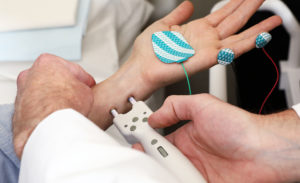
Electromyogram (EMG) and Nerve Conduction Studies (NCS)
What is an Electromyogram?
An electromyogram (EMG) is a diagnostic test used to evaluate the electrical activity of muscles and the associated nerve pathways. It is a valuable tool in assessing neuromuscular disorders, including myopathies, neuropathies, and nerve root compression syndromes. The EMG provides important information about the functioning of muscles and the communication between nerves and muscles.
Electromyograms and nerve conduction studies (NCS) are specialized tests designed to assess the following questions:
- Are nerves and muscles functioning properly?
- Are there any pinched nerves (such as carpal tunnel syndrome) in the arms or legs?
- If there are pinched nerves in the neck or back, are they causing any muscle damage in the arms or legs?
- Are nerves and muscles communicating properly?
We are beginning to investigate the use of ultrasound in diagnosis of nerve and muscle disorders. This painless, non-invasive technique is showing promise in the diagnosis of nerve and muscle disorders.
Electromyogram Preparation
Please bathe the morning of your test but do not apply any lotions to your skin.
You may eat regularly and should take all your prescribed medications beforehand.
Please bring a complete list of your medications to your exam. While there are no medications that prevent testing, some blood-thinning medications necessitate different approaches and techniques.
Please also let the examiner know if you have pacemaker, which does not prevent testing but may also require modifications to the test.
During The Electromyogram
The nerve conductions (NCS) are usually performed first. In these tests, sensors or electrodes (similar to those used for electrocardiograms (ECG or EKG), are taped to a hand or foot. During an EMG procedure, thin needle electrodes are inserted into the muscles under examination. These electrodes detect and record the electrical signals generated by the muscle fibers and the nerves that innervate them. The electrical activity is displayed as a graph or waveform on an oscilloscope or recorded for further analysis.
An external stimulator is applied to the skin at 1-3 points on the arm or leg and used to apply tiny electric shocks to the skin. The system records the response at the hand or foot and how quickly it arrives. Patients describe the feeling as similar to a static shock, a gentle tap by a hammer, or hitting one’s “funny bone”.
A few taps at each location are needed to verify accuracy. Depending on each individual situation, this may be performed at multiple nerves (usually 2-4 in a leg or 4-5 in an arm).

Electromyography (EMG) is usually performed next. This entails a single needle (thinner than those used to draw blood) being inserted into a muscle to record your muscle’s electrical activity with your arm or leg in certain positions for a few seconds each and then at rest for a few seconds.
The activity is shown on a screen and is also heard over a speaker. Most testing requires 5-7 muscles be tested per limb, with shallow muscles in the neck or back sometimes tested as well.
Through this combination of testing the examining physician can answer the questions posed by the exam.
Afterward
You may resume your normal activities, including eating, driving, and exercising. You may occasionally experience some slight muscle pain (comparable to that experienced after mild exercise) or rare bruising.
